Language learning apps are creating a buzz in the e-learning market, and one such popular app is Duolingo. If you are a language learner you probably heard about this app.
When you Google “language learning apps”, the results shown as ELSA, Duolingo, Mondly, and many others, these are some of the best apps to learn a language.
But the question strikes here, with so many learning apps available in the market why develop a language learning app?
You’ll be amazed to know that the e-learning market is expected to reach $400B by 2026, according to Statista. This shows the e-learning market is reaching new heights and opening many growth opportunities for language-learning apps.
So, now is the right time to invest in the language learning app, if you want to create an app like Duolingo we got you covered.
In this blog, we will discuss, the steps to create an app like Duolingo, its necessary features, and the Duolingo app development cost. Let’s dive right in!
Duolingo App Market Statistics
If you are someone who wants to create a language learning app like Duolingo, you must first understand the market. And in order to do that, we must go through market statistics.
- eLearning is the second largest sector on the Google Play store and the third largest on the App Store.
- According to Statista, Duolingo is the leading language learning app in September 2023 with over 16 million users downloads of the app in February 2023.
- In February 2022, top language learning apps generated revenue of almost $27M with in-app purchases from users worldwide.
- Duolingo has generated $13.4 million in revenue during the 2 quarters of 2022.
This data shows the potential of the Duolingo-like app and the e-learning app market. Now that you have some motivation to develop an app like Duolingo, let’s move to the next step where we shall understand the concept of Duolingo.
What is Duolingo App?
Duolingo is a language learning platform. It provides over 95 courses in 35 different languages. It has a gamified interface that is helpful for users to learn any language they want.
Moreover, with quick bite-sized lessons Duolingo makes learning easy. With every finished lesson you’ll earn points and unlock new levels.
It also provides a language learning certificate if the user passes the Duolingo Test which is acceptable with thousands of institutes worldwide.
The app has generated almost 27 million US dollars in revenue so far. Now it offers over 100 language learning courses. In addition, this app is considered the most addictive as Candy Crush Saga by the New York Times.
Now we have talked about Duolingo, let’s take a look at its journey.
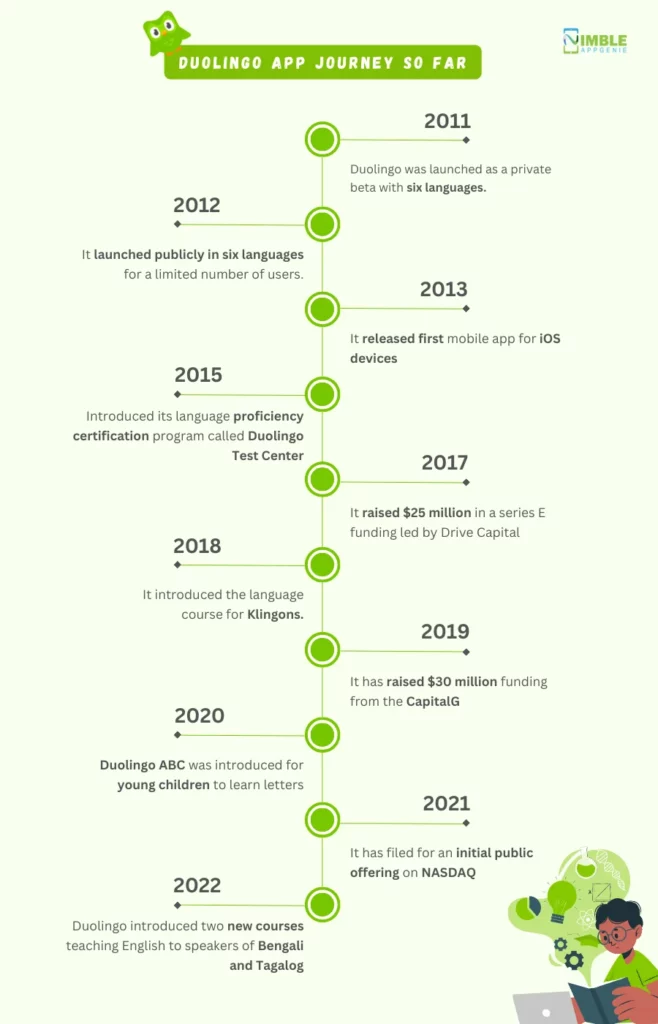
Luis Von Ahn : Creator of Duolingo App
Duolingo was created by Luis Von same person behind Captcha and Recaptcha, he wanted to contribute to education that’s when the Duolingo idea came to his mind. He sold his second company reCAPTCHA to Google and started working on Duolingo.
The motivation behind this app came when he saw how expensive is to learn the English language for his community. Plus, the main goal of this language learning app is to provide an engaging way of learning language for users. So they decided to create a gamified language learning app that is helpful in personalizing lessons for each user.
Duolingo Timeline
| In 2011, on November 27 | Duolingo was launched as a private beta with six languages. It was created by Luis Von Ahn with his post-graduate student Severin Hacker.
|
|---|---|
| In 2012, June 19 | It launched in six languages including English, French, German, Spanish, Portuguese, and Italian for a limited number of users.
|
| In 2013 | It released its first mobile app for iOS devices and won the Best Education Startup award.
|
| In 2015 | Duolingo introduced its language proficiency certification program called Duolingo Test Center, allowing users to get certificates for free. |
| In 2017 | it raised $25M in a series of funding led by Drive Capital, bringing its total funding to $108.3M.
|
| In 2018 | It introduces the language course for Klingons, a fictional language for the Star Trek series. |
| In 2019 | Duolingo has raised $30M F funding from the CapitalG, Google parental company. |
| In 2020 | Duolingo ABC was introduced for young children to learn letters, good for their early foundation years.
|
| In 2021 | It has filed for an initial public offering on NASDAQ, it begins trading on July 28, 2021 |
| In 2022 | Duolingo introduced two new courses teaching English to speakers of Bengali and Tagalog |
Breaking Down The Success of Duolingo
Now, before you get stuck in the thoughts on how to make a language learning app, take a look at the business model that led Duolingo to success.
With so many language learning apps available in the market, what sets this language learning app apart from others?
It’s unique business model.
They started with the vision of making language learning free they stick with this until today. The basic function of the app is still free, but later on, they are generating revenue from premium tiers.
Free education will change the world – Severin Hacker ( Co-founder & current CTO of Duolingo)
Severin Hacker believed that free education could change the world, and he committed to it fully.
However, the company relies mostly on donations, ads, and premium tiers. They focused on user engagement and personalized learning that helped them grow.
“Way to success” is the gamified approach that makes learning easy and engaging. In this way, their user comes back without abandoning their app. Also, they offered less-studied languages such as Hawaiian, Navajo, and High Valyrian from Games of Thrones. With Duolingo, you can greet your friends with “Valar Morghulis”.
So, if you want to make your own language-learning app and want it to be successful. You have to focus on providing a better user experience and focus on creating an app that solves the problems of users.
How Does the Duolingo App Work?
If you want to make an app like Duolingo first know how it works.
Duolingo believed that language learning should be fun – you can see it in the gamification version that keeps users motivated. It also offers with unique language learning course for free.
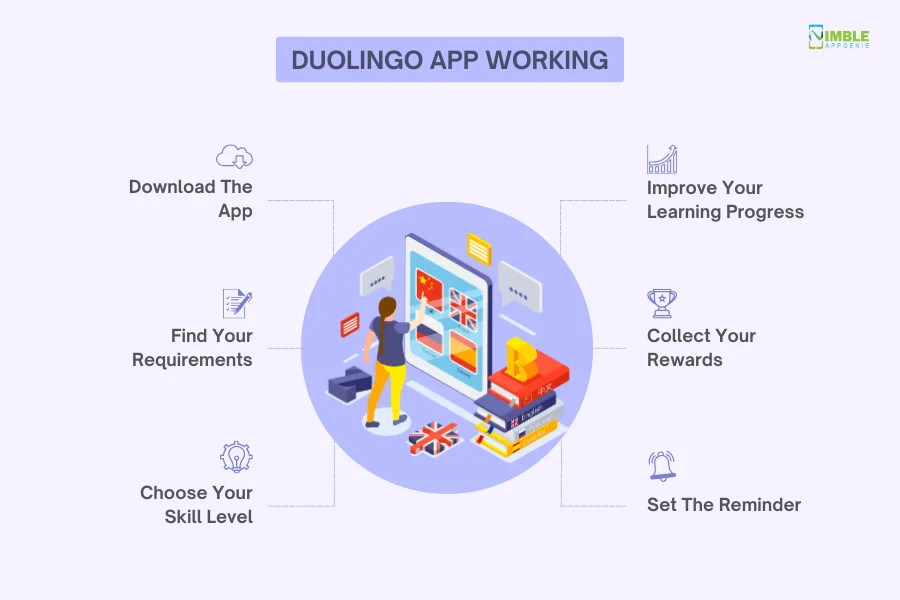
With this being said, let’s break down it working:
Step 1: Download the Duolingo app on your smartphone from the Play Store or Apple App Store. If you want to start with the desktop version then go to duolingo.com and pick a language and you are good to go.
Step 2: It will ask some questions regarding your goals, you can always adjust your goals later, so you can start with the regular option. After that, you’ll be asked to start learning from the beginning or you already know that language.
Step 3: If you want to learn from the beginning, the first option will help you with your very first lesson. Or if you already studied languages, you can take a test and check your level to unlock some courses.
Step 4: After getting started your home screen is designed as a path that you have to follow step by step. Moreover, crossing each path is leveling up as you progress on the path you have to pass more challenging and writing languages.
Step 5: Staying consistent is the biggest challenge in learning a new language. This is why they use gamification methods that make users come back. If you complete lessons you’ll earn points and virtual rewards like hearts and gems.
Step 6: Lastly go to your profile, click on the settings page, and set the reminders to make your studying a habit. Also include listening and speaking habits in your lessons.
What Language Learning Problems Does Duolingo App Solve?
Duolingo, main purpose is to solve high-quality education problems for everyone. If you want to build an app like Duolingo, you have to work on solving major issues of users related to language learning apps. Although it solves 90% of users’ language-learning issues it motivates other businesses to invest in developing apps like Duolingo.
Now before you create your own language learning app, let’s discuss some learning problems that Duolingo has solved.
1. Boring Learning Process
It goes without saying you can buy a book or online language course, but truth be told, it can be boring. Duolingo makes this boring process interesting via gamification.
Now that learning is fun, users can achieve their language learning goals faster and better.
2. Low Credibility of App Content
The majority of language learning platforms don’t focus that much on content credibility and this creates credibility issues among the user base.
Duolingo on the other hand, solves this issue by ensuring its users that the content provided on the platform is checked by the tutors and the AI-based algorithms. Also, they look at the answers offered by the users and validate answers selected by the majority.
Additionally, the app has provided a certification process for users to leverage perks in offline learning programs.
3. No Personalization
Most of these language learning apps don’t offer personal customization options within the app. But when it comes to Duolingo, it has changed the entire language learning scenario. It offers customization options for personal learning that allow users to customize their learning goals and plan their learning journey accordingly.
Top Language Learning Apps Worldwide
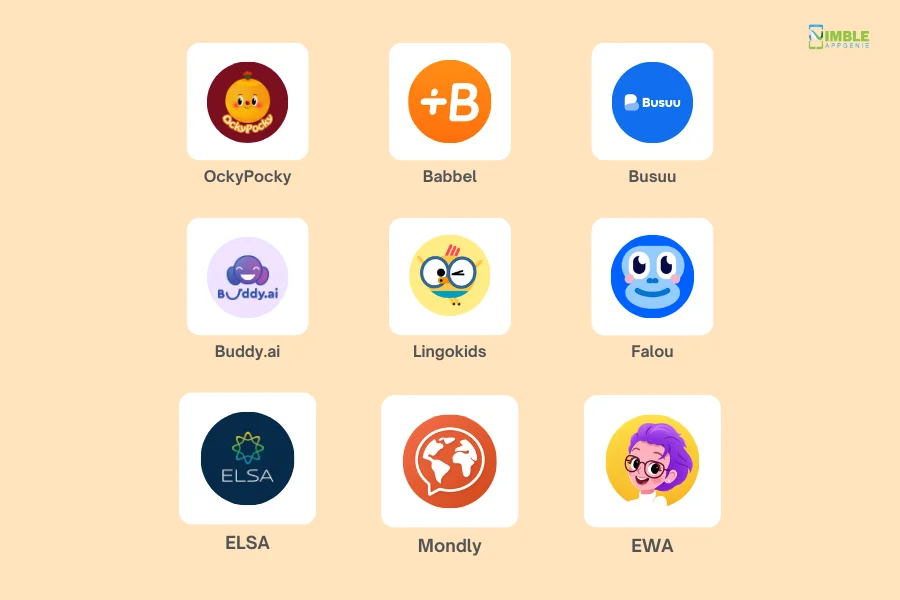
Top Features to Include In Duolingo Like App
Now that we are one step closer to learning “how to build a language learning app” it’s time to discuss features.
Take a look at these top features required to build a Duolingo-like app.
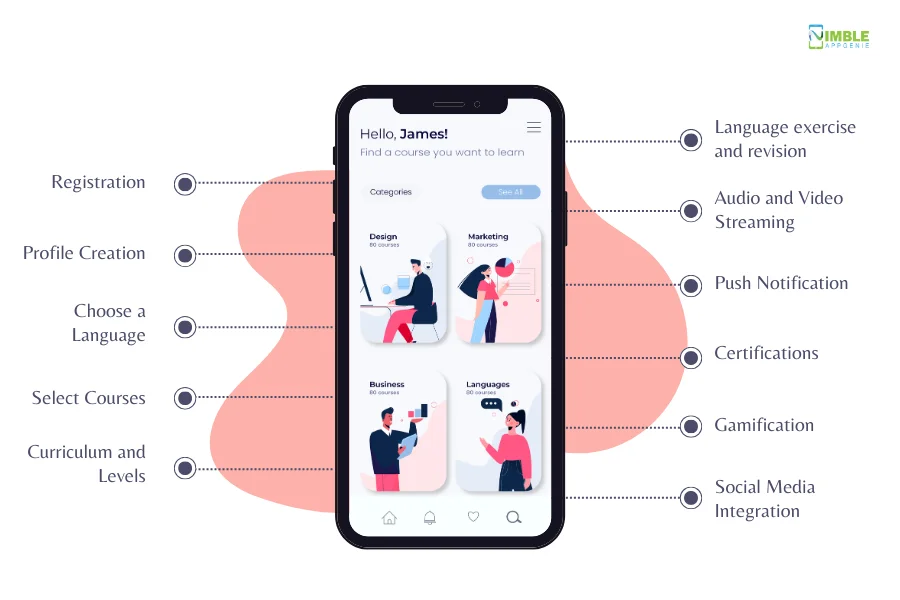
1. Registration or Log-In
This is the foremost feature of every mobile application. With this feature, users can create an account on your app with a sign-up process. Or they can use their existing mail to register to your app.
2. Profile Creation
Profile creation comes secondary after login.
Now, users can create profiles with their personal information, learning preferences, and language goals. With this feature, users can easily customize exercises and lessons according to their needs.
3. Choose A Language
This feature is essential as users can choose the language they want to learn from the available list of options. Also, make sure to provide several language options for diverse learners. This is the most crucial feature of your language learning app you must incorporate it for a good user experience.
4. Select Courses
Within the chosen language, users can select specific courses or topics they want to focus on. These courses can be categorized based on themes, grammar rules, or vocabulary.
With this feature, user can choose the language they want to learn according to their budget. This flexibility will create a better user experience.
5. Difficulty Levels
Integrating this feature will provide users with structured curriculums with different levels of difficulty. Users can start with the basic lessons and keep upgrading their levels when they progress to advanced levels.
6. Language Exercise and Revision
This feature is best when user wants to check their performance. They can take revision tests anytime and enhance their skill level. Also, this feature will help them to find the areas where they are lacking and work on them to improve.
7. Audio and Video Streaming
Duolingo app offers audio and video content such as native speaker conversations, pronunciation guides, and cultural videos. Listening to native speakers helps users to learn better.
With this feature, users can access live videos that create a streamlined learning process.
8. Push Notification
This feature is a must if you want to create an app like Duolingo. Push notifications will give reminders to users to complete the courses.
Plus, users will get regular updates regarding any new guidelines or features.
9. Certifications
If you want your app to be more authentic and reliable you have to provide certificates for completion for users. You can do this by collaborating with the institutes and offering certificates to deserving candidates.
Moreover, by integrating this feature users find your app trustworthy. For this, you have to hire e-learning app developers to make your app more user-friendly.
10. Gamification
Gamification is the core feature of apps like Duolingo. The gaming features will simplify the learning process and streamline the process of learning. And the best thing about these features is they motivate users to complete the courses in a fun way.
The gamified feature can be used in two main areas:
- Experience and levels: Some gamified elements like sound effects and animation make UI engaging.
- Achievements and Badges: After completing any task user awarded with badge or XP. Plus, there is a leaderboard where you can see your progress and achievements.
11. Social Media Integration
Lastly, a social media integration feature is a must if you want to increase users to your app. One of the most prominent features of the e-learning app. Duolingo allows users to log in via their social media accounts.
These features help Duolingo to become the most prominent app among all. Additionally, users can connect their social media accounts to their app, enabling them to share their progress, achievements, and language learning tips with their friends and followers.
Overall, these features are associated with up to 50% of the Duolingo app development cost. By integrating this feature into your app will promote a sense of community and healthy competition.
We are done with the features. Now you have to choose them carefully as they are more likely to affect the cost to develop an app like Duolingo.
How To Create a Language Learning App Like Duolingo?
Duolingo has crossed 500M users worldwide and this number is going to increase in upcoming years.
Therefore, businesses are planning to invest in clone apps like Duolingo. If you are planning to do so, first find a reliable education app development company. Secondly, move forward with strong planning for developing an education app.
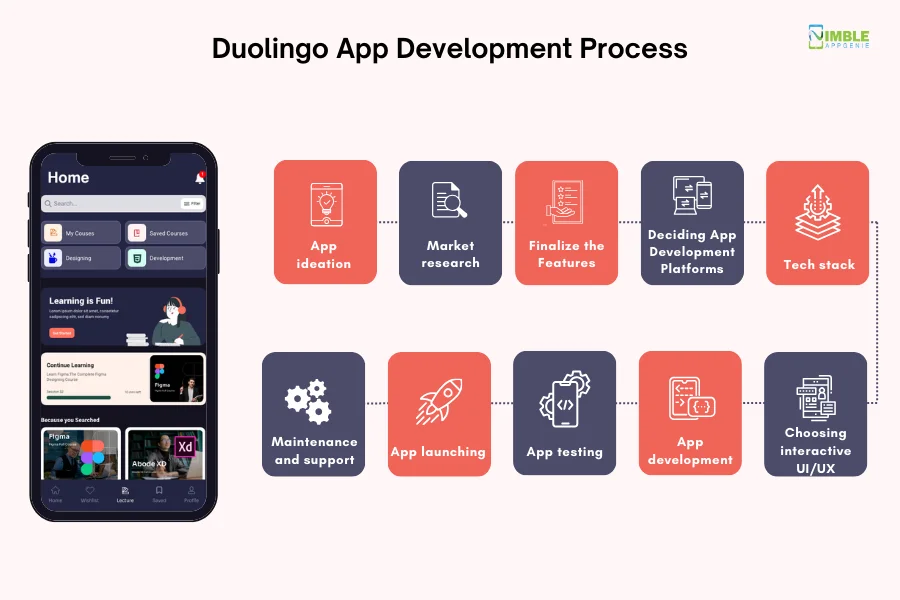
Here is a complete guide to creating an app like Duolingo:
Step 1: Ideation Based on Language Learning Apps
Before you dive into the mobile app development process, you have to clear your head about your language learning app like what features you want to include in your app. The users you want to serve and what is the purpose of your language learning app?
You can do this by brainstorming ideas related to best educational apps and pointing out the important features that serve your app’s purpose.
After that, decide on the features, tech stack, platform, and other things that would help you with the development process.
Step 2: Market Research and Analysis
If you want your app to be successful you have to do quality market research. After ideation, you have to work on market research to ensure the ideas help in the market. While researching the market you’ll come across market gaps, strengths & weaknesses in your competitor’s apps. that you can rectify in your app when you start working on your mobile app development.
Take a look at some questions that you’ll come across while doing market research:
- Is there a need for your app in the market?
- Who is your target audience and what are their preferences?
- What obstacles and competitors are you going to face?
- Do you need MVP development?
- How can you create a marketing strategy?
However, conducting the right market research will help you to validate your app’s idea. Plus, ensure your app is serving existing market needs. Conducting mobile app market research helps in data collection and analysis, here is how you can do market research:
- Start with an analysis of your market competitor.
- Do SWOT analysis
- Conduct survey
- Create polls on social media
Overall, if you conduct market research in the right manner this process can save you time and cost. Now you can do better than your competitors.
Step 3: Finalize the Features of the Language Learning App
The above process helps you with deciding on the features. Half of your work is done when analyzing Duolingo app features, you’ll get to know about the essential features.
Now if you want to add some unique features to your app. For this, you have to determine what will set your app apart from your competitors. This unique selling point will help you with your feature selection.
In addition, create a list of potential features and functionalities for your app. Consider features like:
- Languages courses
- Progress tracking
- Certification
- Social features
- Gamified learning
- Speech recognition
- Audio and video streaming
- In-app purchases
- Language exercise & revision
- Curriculum & levels
Lastly, you can use techniques like the MoSCoW method (Must-have, should have, could-have, won’t have) to categorize features.
Disclaimer: Carefully decide on the features as they can impact Duolingo like app development cost.
Step 4: Deciding Duolingo App Development Platforms
Deciding on an app platform is the most crucial part of the process. Many businesses get confused while choosing the platform they need to develop for language learning apps. So, it’s important to decide on the development platform before moving to the next step.
Doesn’t matter if you start native or cross-platform app development, you’ll need to consider factors like your target audience, budget, development resources, and the features you want to include.
Also, don’t forget to hire mobile app developers that are experts in eLearning app development.
Take a look at some development platforms for language learning.
| Native
|
|
| Cross-platform
|
|
| Web apps
| For cost-effective options, consider creating a web app that works on both mobile and desktop browsers. |
| Hybrid
| Hybrid apps combine web technologies (HTML, CSS, JavaScript) with native app components. |
| AR/VR platforms
| If your app includes augmented reality or virtual reality components for language learning, you may need to target specific platforms or hardware such as Oculus or ARKit for iOS. |
Step 5: Tech Stack for Apps Like Duolingo
In this stage, you have to pick a mobile app tech stack according to your chosen development platform. Different platforms consist of different technology stacks and needs.
For example, if you want to develop an Android app, Kotlin and Java are required, while for iOS app development, Objective C and Swift are required.
After deciding on the tech stack, hire eLearning app developers and start working on the frontend and backend of the app.
Take a look at the tools & technologies, and mobile app development frameworks that Duolingo used. You can use them in your language learning app.
| Frontend development | CSS3 and Bootstrap, backbone.js, jQuery & Twitter Bootstrap |
| Backend development | JavaScript, AngularJS, Python, Django, Ruby and Flask |
| Android app | Java |
| iOS app | Swift |
| Data Storage | Combination of Memcache & Redis |
| Cloud hosting | Google Cloud Platform (GCP) and Amazon Web Services (AWS) |
| For caches | Combination of Redis and Memcache |
| Database | PostgreSQL or MySQL for structured data storage |
| Authentication & Authorization | OAuth 2.0 for user authentication |
| Content delivery | Content delivery networks (CDNs) like Amazon CloudFront or Cloudflare for serving media files |
| Push notifications | Firebase cloud messaging (FCM) Apple push notification or Microsoft Azure speech service |
| APIs and Integration | Third-party language translation APIs for language courses. |
| Security | SSL/TLS for data encryption |
Overall, choosing the right tech stack will accelerate your development process and save you time and cost.
Step 6: Interactive UI/UX
Good user experience is a crucial factor of Duolingo. A poorly designed app will only lead to uninstallation; users will uninstall the app if they find the app difficult to navigate.
However, it’s crucial to design the app minimally and with good UI, so that your language learning app doesn’t get uninstalled frequently.
It’s mandatory to keep a check on the following factors.
- Wireframes
- App usability
- Visual design
- Information Architecture
Ask your team of UI/UX designers to create a lucrative frontend of your app, to create wireframes, mockups, and prototypes of the app. Make sure the app has minimal features and is easy to navigate with the users. Also, ask them to create visually appealing, gamified, and engaging elements.
Step 7: Development Process Apps Like Duolingo
Once you are done with the frontend development, you can start with the backend development of your language learning app.
Start by creating an MVP of your language learning app to ensure your app idea.
Now you are wondering how MVP will help you in your app success.
App development is a lengthy process and costly as well. Creating MVP is an excellent cost-effective solution and at the same time, it will give you an idea of how your target audience is interacting with your app.
If you are low on budget creating an MVP is a great way to start. And if budget is not an issue ask your backend development team to write clean code for your language learning app.
All you have to do is maintain proper communication during the entire development process to sort out any confusion related to your app.
Step 8: App Testing
Mobile app testing is the most crucial part of the process. Once you have completed the development process, ask your team of QA to do rigorous testing.
It’s important to do testing before release to ensure that your final product is free from errors.
However, testing will help you check your app compatibility across different devices, screen sizes, and operating systems. There are various types of testing, such as functional testing, beta testing, and many more.
In this phase user feedback is also important, Beta testing will allow a group of users to try the app and give feedback on the usability and functionality. With this feedback, you can make necessary changes to your app and improve the app before the final launch.
Step 9: App Launching & Marketing
Now if you are satisfied with the testing results, it’s time to launch your language learning app in the market. This process is the start of the business, release your app on major platforms like Play Store and App Store.
After that work on marketing, you can market your app on different social media platforms. Also, you can introduce your language learning app to your website to attract more traffic.
Apart from that you can follow these steps to market your language learning app.
- Create a social media account for your app and directly promote your app on these platforms.
- Collaborate with influencers to promote your learning app.
- Offer a free trial period to lure users to download your app.
- Partner with schools, universities, and language schools to establish credibility and expand your reach.
Step 10: Maintenance and Support
After the successful deployment of your app, the work isn’t over yet. Maintenance of the app is a must whether you do in-house or outsource, invest in support and maintenance services.
In the meantime, your app will face some challenges, to overcome these challenges you must regularly update your app. As the requirements of users are changing with every new launch in the market, to thrive in the market you have to make changes and updates in your app.
Investing in maintenance and support services will ensure your app’s success.
So with this being said, we are done with the language learning platform development guide, let’s move forward to the development cost of an app like Duolingo.
How Much Does Duolingo App Development Cost?
So, how much does the Duolingo app cost?
This is a question that comes up a lot when discussing Duolingo-like app development. However, it is easier to ask than answer.
The reason is that there are various factors that affect the Duolingo app development cost & the smallest factor can fluctuate the cost.
On average, Duolingo app development cost can range between $20,000 and $55,000 based on different factors.
Now, it is impossible to calculate exact app development costs without learning about project specifications. Therefore, if you are looking for a more accurate estimation, we highly recommend that you consult a mobile app development company. This will be able to give you a quote based on your requirements and preferences.
Moving on, with this out of the way, let’s look at some of the major factors and how they affect the total cost to develop an app like Duolingo.
Cost-affecting Factors of the Duolingo App
As we discussed, there are various factors that comes into play when we speak of Duolingo app development cost. In a bid to better understand that, let’s look at some of these major factors. These are, as mentioned below:
1. App Platform
As we have discussed above, the app platform is the first and foremost factor that affects the cost to build a language learning app like Duolingo. It depends on the choice of app platform like Android or iOS as they both significantly affect the development cost. It’s better to choose one platform at initial stage as choosing both will increase the cost.
However, a basic language learning app for a single platform, whether it’s iOS or Android, will cost you up to $20,000 to $30,000.
With moderate features for both platforms will cost you up to $30,000 to $40,000 or more. Or if you have complex features for both platforms like gamified version, VR, and AR the cost can exceed these estimates.
2. Features
Another crucial factor that affects the cost to develop a mobile app is features. Features are the driving force of any app. When you start eLearning app development you add several features to it to make it user-friendly.
For example, if you add gamified features like Duolingo, user interaction features, and personal learning paths, it can affect the development time and cost.
But it’s important to choose features carefully, do not include unnecessary features as it can impact the cost. Also, it can only affect the cost if you add basic or complex features.
Simply, the more complex features will increase the cost and basic features are cheaper to develop.
3. Developer’s Location
Now developer location also impacts the development cost. The cost can vary based on the geographical location of the development team. Developers with higher living costs will charge more than the country with lower living costs.
If you hire developers from the USA or European countries they will charge more as compared to Middle East and Asian countries. Also, the cost of developers depends on their experience, if you hire dedicated developer, with more experience, they will charge higher than the less one.
| In the USA | |
|---|---|
| Junior developers | $50-$100 per hour |
| Mid-level developers | $100-$150 per hour |
| Senior level developers | $150-$250 per hour |
| Europe (UK, France, Germany) | |
|---|---|
| Junior Developers | €40 – €80 per hour |
| Mid-level developers | €80 – €120 per hour |
| Senior developers | €120 – €200 per hour |
| Middle East ( Israel) | |
|---|---|
| Junior developers | $30-$60 per hour |
| Mid-level developers | $60-$100 per hour |
| Senior developers | $100-$150 per hour |
| Asia (India, Philippines) | |
|---|---|
| Junior developers | $10-$30 per hour |
| Mid-level developers | $30-$60 per hour |
| Senior developers | $60-$100 per hour |
Overall these are the approximate hourly rates of developers from different regions. It is recommended to consult the cost while hiring developers from different regions.
4. Tech Stack
Now you are wondering how much it costs to develop an app like Duolingo with an appropriate tech stack. Well, the answer depends on your choice of technologies, frameworks, and tools. They can impact the development costs.
However, there are various tools and technology that is used to develop language learning app. Apart from these, there are various frameworks too. Plus, these programming languages, frameworks, and tools impact the development speed and complexity.
Some technologies have licensing costs and need experts to implement in your app. Using modern technologies and widely used tools can enhance efficiency but licensing tools can increase the cost.
5. Design Process
The designing stage of the development process can affect the cost, as it is time-consuming and costly. The software and tools used for designing elements can add cost.
However, designing an app is a critical component of the user experience, and it can influence both the development timeline and expenses.
If you are developing a complex app that includes graphics, animation can increase design costs. Also, the number of designed screens will result in higher costs.
For instance, it is challenging to provide the exact cost to design the language learning app the rough estimate for design can range up to $5,000 to $10,000. For more complex app the design cost range up to $15,000 to $25,000 or higher.
6. Testing
We have already discussed how testing is crucial for your language learning app. But when it comes to cost, this factor cannot be missed. There are various types of testing whether it’s for security, usability, and performance testing.
Testing phases can add 25% additional cost to the development process. If your app supports multiple languages or regions, you’ll need to perform testing for localization and internationalization.
However, if you want to manage the impact of testing on the cost of your language learning app, it’s important to find the balance through testing and budget constraints. For this, you need an experienced testing team so they can fit the testing budget with your development budget.
With this being said, let’s discuss how you can make money with a language-learning app in the next section.
How to Monetize a Language Learning App Like Duolingo?
Several apps in the market are free to use, so how do apps make money?
Understand the answer to this question with an example. Let’s take the example of Duolingo, it is free to use but in the second quarter of February 2023, it generated almost 127 m U.S. dollars. Amazed right?
Language learning apps use several tactics to make money. One of the most used ways is the subscription model, but it only makes 2% from paid subscriptions. Other revenue generation sources are ads, investors, and collaborations with brands.

Now, let’s discuss mobile app monetization ways more deeply. So, you can choose the best way to monetize your language learning app.
1. Freemium
This is the most popular model, it is perfect for all learning products whether it’s LMS, TMS, or LXP. To unlock the next lessons and learn new materials users have to pay for it.
Now how does it work?
Basically, users can access the app, and take courses without any charge but to explore more features and functionality they have to take a paid subscription.
The drawback of this model: If your app is not engaging enough, or the interface is confusing users will more likely abandon the app without taking any paid plan.
2. In-App Advertisement
This idea came from generating revenue from third-party apps. Simply, users can access free apps in exchange for watching third-party apps.
Such third-party apps, get displayed as rewarded video ads or pop-up ads. Although rewarded video ads are interesting by watching them users get XP, or coins that are useful in the app itself.
Now here, sometimes ads can be very annoying for some users, to remove these ads users have to pay some amount which is a good way of revenue generation.
The drawback of this model: Ads can be annoying sometimes or users feel distracted when it comes to language learning apps. For this reason, users can abandon the app.
3. Subscription Model
In almost every app you can see this mode. The monetization strategy works like this, first user can use the app for a free period of time. After that, you can offer users more features and functionality with subscription options.
However, their subscription model differs by validity period including monthly, annual, and lifetime. Also, the subscription model has auto-renewing and non-renewing approaches.
Auto-renewing seems profitable but in some cases, if the user forgets to cancel the subscription it may get charges that eventually loss of customer loyalty or increase churn.
The drawback of this model: You have to always make your app engaging among users, by providing a better user experience and best features from time to time. Work on their feedback and come up with effective solutions.
4. Paid Apps
It is the least used monetization model among all but also an effective revenue model. Users have to download the app after paying some amount.
To generate revenue from this model you have to provide high-quality learning content that provides real value to the user. The more engaging or valuable your content is, the easier for you to make users pay for your app.
The drawback of this model: The biggest drawback is users must pay for the app before they can access it, this significantly deters potential users who hesitate to pay without trying the app first.
5. In-App Purchase
In this model, you can use an app shop for selling virtual physical goods. Also, virtual products refer to gems, extra life, and avatars. For example, if you are developing a gamified version Duolingo app, in-app purchases will help you with revenue generation.
The drawback of this model: Handling refund requests for accidental purchases or unsatisfied users can be time-consuming and potentially result in disputes.
How to Make Your Language Learning App Successful?
To make your language learning app stand out in the crowded market you have to focus on these techniques to make your app successful. If you have an experienced development partner by your side you don’t have to worry about app success.
Let’s discuss some factors to make your app successful.
1. Focus on target customers
In the initial stages of your development process identify your ideal user needs and preferences. When you understand your user’s goals, language preferences, and proficiency, then tailor your app according to them. This will eventually create a path of success for your app.
2. Real-time translation and writing feature
For language learning apps it is essential to include these features. These features refer to the ability of your app to assist users in writing and translating a foreign language.
If you have this feature in your app, it will help users in solving their practical issues. And if an app solves the real-time problems of users its success is ensured.
3. Localize your app
If you are scaling your app at a global level, localization is essential for your app’s success. This includes translating content into multiple languages and customizing the user experience for various markets. It helps your app to feel relatable to a global audience which significantly increases the user retention rate.
4. Use the latest tech stack
Using the latest tools, up-to-date technologies, and frameworks for app development will eventually accelerate the development time and cost.
Also, if you use cutting-edge tools and technological trends and solutions it will create a seamless user experience. And your app become successful in no time.
5. Interactive UI/UX
A good user experience is the main reason behind the app’s success. If a user can easily navigate your app or your app interface is lucrative, it creates a seamless user experience for the user.
Also, encourage users to explore your app eventually they can enjoy their learning journey.
6. Promote your app
Lastly, if you want your app to be successful in no time, you have to invest in promotion and marketing tactics. You can promote your app by following various strategies such as:
- Social media marketing
- Paid Advertisement
- SEO
- Email marketing
- Partnerships
By following these effective promotion strategies will enhance the usability of your app.
How Nimble AppGenie will help you to make an app like Duolingo?
The market is filled with language learning apps, if you want your app to stand out in the market work with an expert development partner. That provides you with Android or iOS development services.
With years of working experience in the industry, Nimble AppGenie provides cutting-edge solutions for language learning apps for both iOS and Android platforms.
However, Duolingo offers a gamified learning experience to its users and Nimble AppGenie can fulfill that requirement. If you want to incorporate gamification elements like points, badges, and leaderboards to motivate your users. We help you implement and design these features.
Our team of expert developers has vast experience in building the latest learning apps if you want to create a language learning app like Duolingo, choose us.
Conclusion
Creating an app like Duolingo can be challenging and rewarding at the same time. The language learning app solves the real-life issue of the user, it has replaced traditional learning methods and ended the language learning barrier for the user across the world.
We have already discussed the revenue generated by the Duolingo app, so there is no need to explain the revenue-generating potential in this industry.
This is why many investors and businesses are willing to invest in this niche but many fail due to a lack of experienced development partners by their side. If you want to create a language learning app this Duolingo app development guide helps you with everything. If you want to know more about eLearning app development costs, feel free to connect with us.
FAQs
The average cost of developing a language learning app ranges from $20,000 to $55,000 or more depending on your app needs and complexity. However, you should consult the cost with an expert development partner before investing in one.
Developing an app like Duolingo can be time-consuming, it requires a lot of time and patience to build a language learning app. It could take approx. 5 to 9 months or more depending on your app’s complexity and requirements.
If you want to reduce the cost of developing a language learning app, first find a reliable partner that has good experience in developing a language learning app. Secondly, in the initial stage of development create strong planning regarding your app goals. This will eliminate the confusion in the development process and reduce the cost at the same time.
To create a language learning app like Duolingo, you’ll require the following team:
- Expert developers (web developers, system developers)
- Project manager
- QA team
- Business Analyst
- 2D/3D artist
- React Native developer
- DevOps
The popular learning app includes features such as:
- Interactive lessons
- Multiple-language support
- Leader boards
- Social media integration
- Audio and Video streaming services
There are several ways to generate revenue from your language learning app like Duolingo. Here are some commonly used methods:
- Freemium model
- Subscription model
- Paid model
- In-app purchases
- Paid Advertisement
The best way to motivate users is by providing a good user experience. Secondly, don’t forget to offer personalized content and recommendations based on user progress and learning preferences. Additionally, you follow several strategies such as:
- Gamification
- Progress tracking
- Rewards and challenges
- Social features
- Offline access

Niketan Sharma is the CTO of Nimble AppGenie, a prominent website and mobile app development company in the USA that is delivering excellence with a commitment to boosting business growth & maximizing customer satisfaction. He is a highly motivated individual who helps SMEs and startups grow in this dynamic market with the latest technology and innovation.
Table of Contents




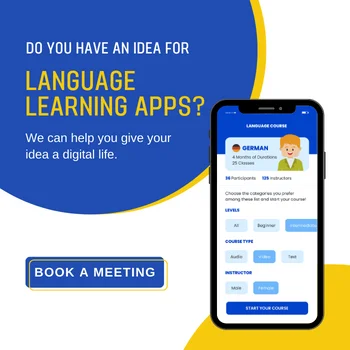

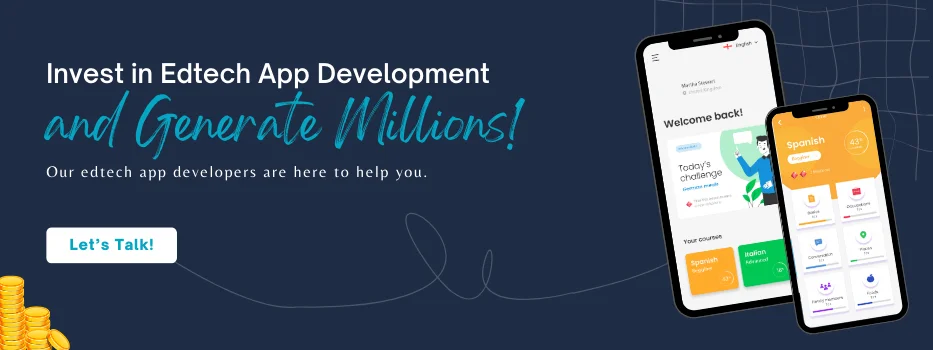








No Comments
Comments are closed.